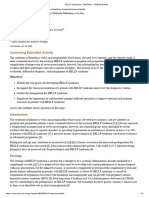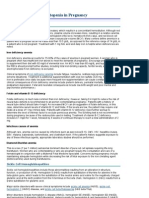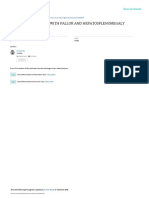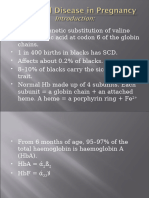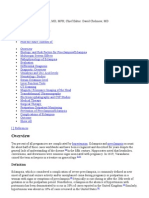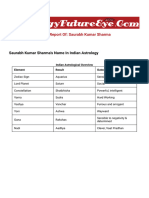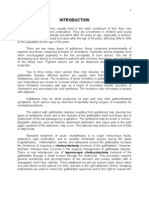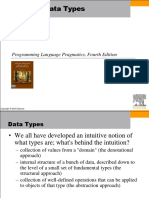Sickle
Sickle
Uploaded by
Nalini T GanesanCopyright:
Available Formats
Sickle
Sickle
Uploaded by
Nalini T GanesanCopyright
Available Formats
Share this document
Did you find this document useful?
Is this content inappropriate?
Copyright:
Available Formats
Sickle
Sickle
Uploaded by
Nalini T GanesanCopyright:
Available Formats
Sickle Cell Disease
Essentials of Diagnosis & Typical Features Neonatal screening test with hemoglobins FS, FSC, or FSA. African, Mediterranean, Middle Eastern, Indian, or Caribbean ancestry. Anemia, elevated reticulocyte count, jaundice. Recurrent episodes of musculoskeletal or abdominal pain. Hemoglobin electrophoresis with hemoglobins S and F; hemoglobins S and C; or hemoglobins S, A, and F with S > A. Splenomegaly in early childhood with later disappearance. High risk of bacterial sepsis.
General Considerations
A high prevalence of sickle hemoglobin is found in persons of central African origin. It also occurs in other ethnic groups in Italy, Greece, Turkey, Saudi Arabia, and India. Sickle cell anemia is caused by homozygosity for the sickle gene and is the most common form of sickle cell disease. Other clinically important sickling disorders are compound heterozygous conditions in which the sickle gene interacts with genes for hemoglobins C, DPunjab, OArab, CHarlem, or -thalassemia.
Overall, sickle cell disease occurs in about 1 of every 400 African American infants. Eight percent of African Americans are heterozygous carriers of the sickle gene and are said to have sickle cell trait.
The protean clinical manifestations of sickle hemoglobinopathies can be linked directly or indirectly to the propensity of deoxygenated hemoglobin S to polymerize. Polymerization of sickle hemoglobin distorts erythrocyte morphology, decreases red cell deformability, causes a marked reduction in red cell life span, increases blood viscosity, and predisposes to episodes of vaso-occlusion.
Neonatal screening for sickle hemoglobinopathies is now routine in most of the United States. The identification of affected infants at birth, when combined with follow-up programs of parental education, comprehensive medical care, and prophylactic penicillin, markedly reduces morbidity and mortality in early childhood.
Clinical Findings
Symptoms and Signs
These are related to the hemolytic anemia and to tissue ischemia and organ dysfunction caused by vaso-occlusion. Physical findings are normal at birth, and symptoms are unusual before age 34 months because high levels of fetal hemoglobin inhibit sickling. A moderately severe hemolytic anemia may be present by age 1 year. This causes pallor, fatigue, and jaundice, and predisposes to the development of gallstones during childhood and adolescence. Intense congestion of the spleen with sickled cells may cause splenomegaly in early childhood and results in functional asplenia as early as age 3 months. This places children at great risk for overwhelming infection with encapsulated bacteria, particularly pneumococci. Up to 30% of patients experience one or more episodes of acute splenic sequestration, characterized by sudden enlargement of the spleen with pooling of red cells, acute exacerbation of anemia, and, in severe cases, shock and death. Acute exacerbation of anemia also occurs with aplastic crises, usually caused by infection with human parvovirus, and other viruses.
Recurrent episodes of vaso-occlusion and tissue ischemia cause acute and chronic problems. Dactylitis, or hand-and-foot syndrome, is the most common initial symptom of the disease and occurs in up to 50% of children before age 3 years. Recurrent episodes of abdominal and musculoskeletal pain may occur throughout life. Strokes occur in about 8% of children and tend to be recurrent. The so-called acute chest syndrome, characterized by fever, pleuritic chest pain, and acute pulmonary infiltrates with hypoxemia, is caused by pulmonary infection, infarction, or fat embolism from ischemic bone marrow. All tissues are susceptible to damage from vaso-occlusion, and multiple organ dysfunction is common by adulthood. Table 282 lists the common manifestations of sickle cell disease in children and adults.
Table 282. Common Clinical Manifestations of Sickle Cell Disease.
Acute Children Bacterial sepsis or meningitisa Splenic sequestrationa Aplastic crisis Vaso-occlusive events Dactylitis Bone infarction
Chronic Functional asplenia Delayed growth and development
Avascular necrosis of the hip Hyposthenuria Cholelithiasis
Acute chest syndromea Strokea Priapism Adults Bacterial sepsisa Aplastic crisis Vaso-occlusive events Bone infarction Acute chest syndromea Strokea Priapism Acute multiorgan failure syndromea Leg ulcers Proliferative retinopathy Avascular necrosis of the hip Cholecystitis Chronic organ failurea Liver Lung Kidney Decreased fertility
Associated with significant mortality rate.
Laboratory Findings
Children with sickle cell anemia (homozygous sickle cell disease) generally show a baseline hemoglobin level of 710 g/dL. This value may fall to life-threatening levels at the time of a sequestration or aplastic crisis. The baseline reticulocyte count is elevated markedly. The anemia is usually normocytic or macrocytic, and the peripheral blood smear typically shows the characteristic sickle cells as well as numerous target cells. Patients with sickle -thalassemia also generally have a low MCV and hypochromia. Those with sickle +-thalassemia tend to have less hemolysis and anemia. Persons with sickle hemoglobin C disease have fewer sickle forms and more target cells, and the hemoglobin level may be normal or only slightly decreased because the rate of hemolysis is much less than in sickle cell anemia.
Most infants with sickle hemoglobinopathies born in the United States are identified by neonatal screening. Results indicative of possible sickle cell disease require prompt confirmation with
hemoglobin electrophoresis. Children with sickle cell anemia and with sickle 0-thalassemia have only hemoglobins S and F. Persons with sickle +-thalassemia have a preponderance of hemoglobin S with a lesser amount of hemoglobin A. Persons with sickle hemoglobin C disease have equal amounts of hemoglobins S and C. The use of solubility tests to screen for the presence of sickle hemoglobin should be avoided because a negative result is frequently encountered in infants with sickle cell disease, and because a positive result in an older child does not differentiate sickle cell trait from sickle cell disease. Thus, hemoglobin electrophoresis is always necessary to accurately identify a sickle disorder.
Differential Diagnosis
Hemoglobin electrophoresis and sometimes hematologic studies of the parents are usually sufficient to confirm the correct diagnosis of a sickle cell disorder. Infants whose neonatal screening test shows only hemoglobins F and S occasionally have disorders other than sickle cell anemia or sickle 0-thalassemia. The most important of these disorders is a compound heterozygous condition of sickle hemoglobin and pancellular hereditary persistence of fetal hemoglobin. Such children, when older, typically have 30% fetal hemoglobin and 70% hemoglobin S, but they do not have significant anemia or develop vasoocclusive episodes.
Complications
Repeated tissue ischemia and infarction causes damage to virtually every organ system. Table 282 lists the most important complications. Patients who require multiple transfusions are at risk of developing transfusion-related hemosiderosis and red cell alloantibodies.
Treatment
The cornerstone of treatment is enrollment in a program involving patient and family education, comprehensive outpatient care, and appropriate treatment of acute complications. Important to the success of such a program are psychosocial services, blood bank services, and the ready availability of baseline patient information in the setting in which acute illnesses are evaluated and treated. Management of sickle cell anemia and sickle 0-thalassemia includes prophylactic penicillin, which should be initiated by age 2 months and continued at least until age 5 years.
The routine use of penicillin prophylaxis in sickle hemoglobin C disease and sickle +-thalassemia is controversial. Pneumococcal conjugate and polysaccharide vaccine should be administered to all children who have sickle cell disease. Other routine immunizations, including yearly vaccination against influenza, should be provided. All illnesses associated with fever greater than 38.5C should be evaluated promptly, bacterial cultures performed, parenteral broad-spectrum antibiotics administered, and careful inpatient or outpatient observation conducted.
Treatment of painful vaso-occlusive episodes includes the maintenance of adequate hydration (with avoidance of overhydration), correction of acidosis if present, administration of adequate analgesia, maintenance of normal oxygen saturation, and the treatment of any associated infections.
Red cell transfusions play an important role in management. Transfusions are indicated to improve oxygen-carrying capacity during acute severe exacerbations of anemia, as occurs during episodes of splenic sequestration or aplastic crisis. Red cell transfusions are not indicated for the treatment of chronic steady-state anemia, which is usually well tolerated, or for uncomplicated episodes of vasoocclusive pain. Simple or partial exchange transfusion to reduce the percentage of circulating sickle cells is indicated for some severe acute vaso-occlusive events and may be lifesaving. These events include stroke, moderate to severe acute chest syndrome, and acute life-threatening failure of other organs. Transfusions may also be used prior to high-risk procedures such as surgery with general anesthesia and arteriograms with ionic contrast materials. Some patients who develop severe vasoocclusive complications may benefit from chronic transfusion therapy. The most common indication for transfusion is stroke. Without transfusions, children with stroke have a 7080% chance of recurrent stroke within a 2-year period. This risk of recurrent neurologic events is reduced markedly by the transfusion therapy.
Successful stem cell transplantation cures sickle cell disease, but to date its use has been limited because of the risks associated with the procedure, the inability to predict in young children the severity of future complications, and the paucity of HLA-identical sibling donors. Daily administration of oral hydroxyurea increases levels of fetal hemoglobin, decreases hemolysis, and reduces by 50% episodes of pain in severely affected adults with sickle cell anemia. The hematologic effects and short-term toxicity of hydroxyurea in children are similar to those in adults. Thus hydroxyurea is being used increasingly for selected children and adolescents who have frequent, severe complications.
Prognosis
Early identification by neonatal screening of infants with sickle cell disease, combined with comprehensive care that includes prophylactic penicillin, has markedly reduced mortality in childhood. Most patients now live well into adulthood, but eventually succumb to complications. Academy of Pediatrics, Section on Hematology/Oncology and Committee on Genetics: Health supervision for children with sickle cell disease. Pediatrics 2002;109:526. [PMID: 11875155]
Raphael RI: Pathophysiology and treatment of sickle cell disease. Clin Adv Hematol Oncol 2005;3:492. [PMID: 16167028]
Vichinsky EP: Causes and outcomes of the acute chest syndrome in sickle cell disease. N Engl J Med 2000;342:1855. [PMID: 10861320]
Walters MC: Bone marrow transplantation for sickle cell disease. N Engl J Med 1996;335:369. [PMID: 8663884]
Sickle Cell Trait
Individuals who are heterozygous for the sickle gene are said to have sickle cell trait. This genetic carrier state occurs in 8% of African Americans and is more common in some areas of Africa and the Middle East. Infants with sickle cell trait are identified by neonatal screening results that show hemoglobin FAS. Accurate identification of older persons with sickle cell trait depends on hemoglobin electrophoresis, which typically shows about 60% hemoglobin A and about 40% hemoglobin S. No anemia or hemolysis is present, and the physical examination is normal. Persons with sickle cell trait are generally healthy, and experience no illness attributable to the presence of sickle hemoglobin in their red cells. Life expectancy is normal.
Sickle trait erythrocytes are capable of sickling, particularly under conditions of significant hypoxemia, and several clinical abnormalities have been linked to this genetic carrier state. Exposure to environmental hypoxia (altitude > 3100 m [10,000 ft] above sea level) may precipitate splenic infarction. However, most persons with sickle cell trait who choose to visit such altitudes for skiing, hiking, or climbing do so without difficulty. Many develop some degree of hyposthenuria, and about 4% experience painless hematuria, usually microscopic but occasionally macroscopic. For the most part, these renal abnormalities are subclinical and do not progress to significant renal dysfunction. The incidence of bacteriuria and pyelonephritis may be increased during pregnancy, but overall rates of maternal and infant morbidity and mortality are not affected by the presence of sickle cell trait in the pregnant woman.
An epidemiologic study of army recruits in military basic training found a higher risk of sudden unexplained death following strenuous exertion in recruits with sickle cell trait than in those with normal hemoglobin. This study has raised concerns about exercise and exertion for persons with the trait. However, considerable evidence suggests that exercise is generally safe and that athletic performance is not adversely affected by sickle cell trait. Exercise tolerance is normal, and the incidence of sickle cell trait in black professional football players is similar to that of the general African-American population, suggesting no barrier to achievement in such a physically demanding profession. Thus, restrictions on athletic competition for children with sickle cell trait are not warranted. Sickle cell trait is most significant for its genetic implications.
You might also like
- Science - A Closer Look - Reading Essentials G1 PDFDocument215 pagesScience - A Closer Look - Reading Essentials G1 PDFvoiddoor100% (10)
- Quick Review/Pearl Sheet: These Are in Random Order To Help You Prepare For You NBME ExamDocument19 pagesQuick Review/Pearl Sheet: These Are in Random Order To Help You Prepare For You NBME ExamWyoXPat100% (12)
- Dramaturgical PacketDocument29 pagesDramaturgical Packetapi-383824116100% (1)
- Free Tattoo Designs PDFDocument51 pagesFree Tattoo Designs PDFphoto shopNo ratings yet
- Manhattan Case StudyDocument5 pagesManhattan Case StudyPatricia Ann Tampos100% (1)
- Thrombocytopenia in PregnancyDocument12 pagesThrombocytopenia in PregnancyzoyaNo ratings yet
- Clipp Case 30Document9 pagesClipp Case 30manzooradilNo ratings yet
- PDI Vs NQNDocument4 pagesPDI Vs NQNKUNALJAYNo ratings yet
- Sickle CellDocument16 pagesSickle CellAnastasiafynnNo ratings yet
- lec. of HEMATOLOGYDocument19 pageslec. of HEMATOLOGYMohammad AliNo ratings yet
- Biochemistry of Sickle Cell AneamiaDocument14 pagesBiochemistry of Sickle Cell AneamiaehighaokhuoobehiNo ratings yet
- BRS Pediatrics (Dragged)Document3 pagesBRS Pediatrics (Dragged)amjdnuaimyNo ratings yet
- Sickle Cell Disease (Diagnosis and Treatment) Copy CopyDocument8 pagesSickle Cell Disease (Diagnosis and Treatment) Copy Copysufian JaganyNo ratings yet
- Mini-Review: Neonatal PolycythaemiaDocument3 pagesMini-Review: Neonatal PolycythaemiaElizabeth HendersonNo ratings yet
- Jessica Reid-Adam: Department of Pediatrics, Icahn School of Medicine at Mount Sinai, New York, NYDocument3 pagesJessica Reid-Adam: Department of Pediatrics, Icahn School of Medicine at Mount Sinai, New York, NYAnastasia Widha SylvianiNo ratings yet
- Sickle Cell DiseaseDocument37 pagesSickle Cell DiseaseGloria KikiNo ratings yet
- HELLP Syndrome - StatPearls - NCBI BookshelfDocument8 pagesHELLP Syndrome - StatPearls - NCBI BookshelfbanghirotadagantenkNo ratings yet
- HEMOLYTICDocument4 pagesHEMOLYTICzainabd1964No ratings yet
- Genes and Human Disease: Monogenic DiseasesDocument8 pagesGenes and Human Disease: Monogenic DiseasesE.R.ONo ratings yet
- Genes and Human Disease: Monogenic DiseasesDocument8 pagesGenes and Human Disease: Monogenic DiseasesE.R.ONo ratings yet
- лекции англDocument17 pagesлекции англBrett StevensonNo ratings yet
- 2022 Hematol Oncol Clin N Am - Complicaciones de La Anemia Hemolítica AutoinmuneDocument11 pages2022 Hematol Oncol Clin N Am - Complicaciones de La Anemia Hemolítica Autoinmunecostamed tulumNo ratings yet
- Thrombocytopenia Andanemiaininfants A ND Children: Michael RechtDocument19 pagesThrombocytopenia Andanemiaininfants A ND Children: Michael RechtnadaNo ratings yet
- Management of Sickle Cell Disease in Children: Review ArticleDocument8 pagesManagement of Sickle Cell Disease in Children: Review ArticleH. MD EbrNo ratings yet
- Approach To A Child With Pallor and Hepatosplenomegaly: Anirban DasDocument8 pagesApproach To A Child With Pallor and Hepatosplenomegaly: Anirban DasvgmanjunathNo ratings yet
- Clinical ReviewDocument8 pagesClinical ReviewAgus WijayaNo ratings yet
- 101 FullDocument15 pages101 FullhelinNo ratings yet
- Pediatric Spot Diagnosis: Abdulrahman BashireDocument20 pagesPediatric Spot Diagnosis: Abdulrahman Bashireعبدالرحمن بشير100% (1)
- MRCPCH Guide EndoDocument7 pagesMRCPCH Guide EndoRajiv KabadNo ratings yet
- Universidad Privada San Juan Bautista: Escuela de Medicina HumanaDocument6 pagesUniversidad Privada San Juan Bautista: Escuela de Medicina HumanaKarolLeylaNo ratings yet
- Sickle Cell Disease in PregnancyDocument14 pagesSickle Cell Disease in PregnancyJohn HawkinsNo ratings yet
- Antiphospholipid Antibody Syndrome and PregnancyDocument17 pagesAntiphospholipid Antibody Syndrome and Pregnancybidan22No ratings yet
- Hematology McqsDocument63 pagesHematology McqsGalaleldin AliNo ratings yet
- Hemolytic Anemia in PregnancyDocument3 pagesHemolytic Anemia in PregnancyayuyogiNo ratings yet
- Amniotic Fluid Embolism ArticleDocument3 pagesAmniotic Fluid Embolism ArticleShailesh JainNo ratings yet
- EclampsiaDocument14 pagesEclampsiaUmi PulunganNo ratings yet
- Pre EclampsiaDocument12 pagesPre EclampsiaJohn Mark PocsidioNo ratings yet
- HrsDocument6 pagesHrsrehankhankhanNo ratings yet
- Hematuria Differential Diagnoses: Diagnostic ConsiderationsDocument4 pagesHematuria Differential Diagnoses: Diagnostic ConsiderationsRuth linayantiNo ratings yet
- SMFM Sickle Cell Disease in PregnancyDocument24 pagesSMFM Sickle Cell Disease in PregnancyAngela FernandezNo ratings yet
- GROUP 6Document48 pagesGROUP 6Stanleyniiafotey OtuNo ratings yet
- SICKLE CELLSDocument5 pagesSICKLE CELLSSimon LexsNo ratings yet
- SCD and Hydroxyurea TherapyDocument29 pagesSCD and Hydroxyurea Therapysamuel waiswaNo ratings yet
- Antiphospholipid SyndromeDocument8 pagesAntiphospholipid SyndromeVijeyachandhar DorairajNo ratings yet
- Running Head: Sickle Cell Anemia 1Document11 pagesRunning Head: Sickle Cell Anemia 1api-264952333No ratings yet
- Peds Review: Blood/Neoplastic Disorders: Factor VIII Clotting Prolonged Partial Thromboplastin TimeDocument4 pagesPeds Review: Blood/Neoplastic Disorders: Factor VIII Clotting Prolonged Partial Thromboplastin TimeDiana HyltonNo ratings yet
- Sickle Cell DiseaseDocument6 pagesSickle Cell DiseaseMai Hunny100% (1)
- A Case Report On Sickle Cell Disease With Hemolyti PDFDocument4 pagesA Case Report On Sickle Cell Disease With Hemolyti PDFAlhaji SwarrayNo ratings yet
- Neonatal Anemia: Unraveling the Hematological Tapestry of New BeginningsFrom EverandNeonatal Anemia: Unraveling the Hematological Tapestry of New BeginningsNo ratings yet
- PEBjournalDocument8 pagesPEBjournalLisa Linggi'AlloNo ratings yet
- Pediatric Acute Anemia PDFDocument6 pagesPediatric Acute Anemia PDFpurwanto nugrohoNo ratings yet
- Hereditary SpherocytosisDocument23 pagesHereditary SpherocytosisKashan SiddiquiNo ratings yet
- Sickle Cell AnemiaDocument34 pagesSickle Cell AnemiaEmmanuel UsikuNo ratings yet
- Management of Jaundice in Pregnancy 2010Document7 pagesManagement of Jaundice in Pregnancy 2010Dhisa Zainita HabsariNo ratings yet
- Prep For USMLEDocument96 pagesPrep For USMLEdrhassam90No ratings yet
- Sickle Cell PresentationDocument4 pagesSickle Cell PresentationJoan ChoiNo ratings yet
- Term Paper Sickle Cell DiseaseDocument6 pagesTerm Paper Sickle Cell Diseasec5p64m3t100% (1)
- Brief: Henoch-Schönlein PurpuraDocument5 pagesBrief: Henoch-Schönlein PurpuraAdrian KhomanNo ratings yet
- Consensus and Audit Potential For Steroid Responsive Nephrotic SyndromeDocument7 pagesConsensus and Audit Potential For Steroid Responsive Nephrotic Syndromedanielleon65No ratings yet
- NewDocument233 pagesNewRohit Gadkari100% (1)
- Sickle Cell Disease Is An Inherited Disorder in Which Red Blood CellsDocument5 pagesSickle Cell Disease Is An Inherited Disorder in Which Red Blood Cellsjhonnyboy33No ratings yet
- Evaluation of Pallor in ChildrenDocument23 pagesEvaluation of Pallor in ChildrenFlorie Lei BulosNo ratings yet
- Sindrom Hellp MedscapeDocument20 pagesSindrom Hellp Medscapeysh_girlNo ratings yet
- SICKLE CELL ANEMIADocument14 pagesSICKLE CELL ANEMIAboopalant96No ratings yet
- Sickle Cell enDocument9 pagesSickle Cell enbatraz79No ratings yet
- Unit - 2 POETRY SUMMARYDocument8 pagesUnit - 2 POETRY SUMMARYpranajitdeb04No ratings yet
- Astrology SaurabhDocument3 pagesAstrology SaurabhsharmasaurabhkumarfbgNo ratings yet
- Torts - FinalDocument10 pagesTorts - FinalBayani Kamporedondo100% (1)
- Bioethics in Social ContextDocument8 pagesBioethics in Social ContextsarasNo ratings yet
- Rice BowlDocument8 pagesRice BowlEntiz CoyNo ratings yet
- DLL - Science 3 - Q4 - W7Document3 pagesDLL - Science 3 - Q4 - W7Rose Dagdag-LaguitaoNo ratings yet
- Paper Lips1Document11 pagesPaper Lips1dominiqueNo ratings yet
- DFT Lab DescriptionDocument22 pagesDFT Lab DescriptionElla ColonNo ratings yet
- Module 1 - Introduction To Networking PresentationDocument25 pagesModule 1 - Introduction To Networking PresentationsfnjhnmnjNo ratings yet
- Cholecystitis Repaired)Document38 pagesCholecystitis Repaired)Keicy DazaNo ratings yet
- New Microsoft Office Excel WorksheetDocument321 pagesNew Microsoft Office Excel WorksheetAnonymous XfEqCHNo ratings yet
- Nature Versus Nurture in The Gender DivideDocument19 pagesNature Versus Nurture in The Gender DivideAbdul Haadi ButtNo ratings yet
- Chapter 7:: Data Types: Programming Language Pragmatics, Fourth EditionDocument21 pagesChapter 7:: Data Types: Programming Language Pragmatics, Fourth EditionJaviera CabreraNo ratings yet
- Problem Set 12: Massachusetts Institute of Technology Prof. Albert R Meyer Prof. Adam ChlipalaDocument4 pagesProblem Set 12: Massachusetts Institute of Technology Prof. Albert R Meyer Prof. Adam ChlipalaJosmar AlejandroNo ratings yet
- Cuet Special (Verbal Ability) - 1 FNDocument11 pagesCuet Special (Verbal Ability) - 1 FNkrishnakalyani0007No ratings yet
- The Present TenseDocument11 pagesThe Present Tenseyour mamaNo ratings yet
- The Legal Basis of Math-1Document5 pagesThe Legal Basis of Math-1hartatiNo ratings yet
- Coastal HazardsDocument839 pagesCoastal Hazardsgustavo torresNo ratings yet
- Rule 111 and 112 DigestsDocument15 pagesRule 111 and 112 Digestsjuris_No ratings yet
- Math 10 - Equation of A Circle Lesson PLDocument5 pagesMath 10 - Equation of A Circle Lesson PLJoyce anne ilumba100% (1)
- متفوقين ادبي جلسةDocument59 pagesمتفوقين ادبي جلسةL QatNo ratings yet
- CISM AssignmentDocument2 pagesCISM AssignmentRISHABH KUMAR SINGHNo ratings yet
- Selection of Appropriate Software Development Life Cycle Using Fuzzy LogicDocument16 pagesSelection of Appropriate Software Development Life Cycle Using Fuzzy LogicTįtánìâ Rïyå-çhànNo ratings yet
- The Effect of IFRS Convergence On Value Relevance of Accounting Information: Cross-Country Analysis of Indonesia, Malaysia, and SingaporeDocument20 pagesThe Effect of IFRS Convergence On Value Relevance of Accounting Information: Cross-Country Analysis of Indonesia, Malaysia, and SingaporeMohammad Arfandi AdnanNo ratings yet
- Nervous SystemDocument14 pagesNervous SystemShayu ShaNo ratings yet
















